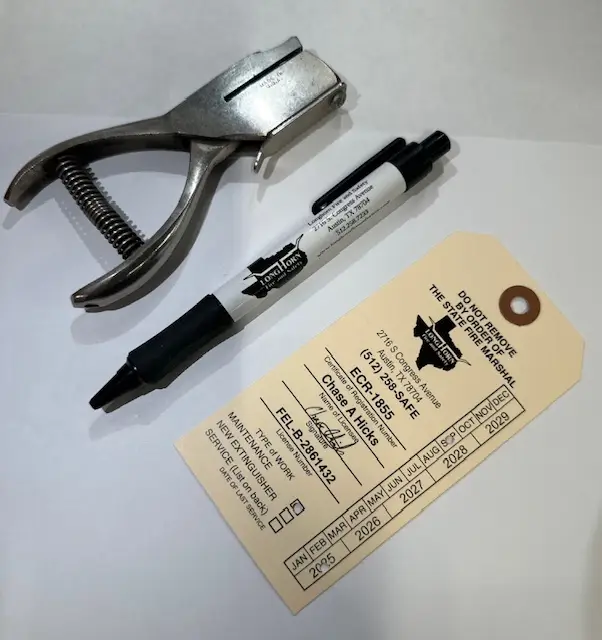


AUSTIN
(512) 258-7233
SAN ANTONIO
(210) 665-7233
Not all fire extinguishers are the same—each is designed to fight specific types of fires. Some are multipurpose, while others target only one hazard. Here’s a breakdown of the main fire extinguisher classes that we carry:
Class A – For ordinary combustibles like wood, paper, cloth, and trash. The number rating tells you the approximate amount of fire (measured in square feet) it can put out.
Class B – For flammable liquids such as grease, gasoline, oil, and paint. The number rating shows how much surface area of a liquid fire a non-expert can safely extinguish.
Class C – For energized electrical equipment, including motors, transformers, appliances, and wiring. These extinguishers use non-conductive agents to put out the fire without risk of shock.
Class D – For combustible metals like magnesium, titanium, sodium, or potassium. These extinguishers are specialized for metal hazards and do not carry a numerical rating.
Class K – For commercial kitchen fires fueled by cooking oils and fats (both animal and vegetable). They cool and smother high-temperature grease fires to prevent re-ignition.
A 2.5 lb ABC fire extinguisher can be a good start for basic home protection — especially for small areas like a kitchen, laundry room, or vehicle.
However, whether it’s “good enough” depends on the layout and fire risks in your home.
Larger homes, garages, and outdoor areas often need multiple or larger units to meet NFPA 10 recommendations and provide enough discharge time to actually put out a fire. A single small extinguisher may empty in just a few seconds — leaving you under-protected when seconds matter most.
If your business operates in Travis County, Williamson County, Caldwell, Bastrop, Hays, Blanco, or Burnet County (or almost anywhere in Texas), you’re required to follow the NFPA 10 fire extinguisher inspection standards — the same code enforced by the City of Austin Fire Department and the Travis County Fire Marshal.
Here’s what that means for you:
Monthly: A quick visual check by your on-site team to confirm each extinguisher is charged, accessible, and free of damage.
Annually: A full fire extinguisher inspection and maintenance service performed by a licensed fire protection company like Longhorn Fire & Safety. This includes tagging, recordkeeping, and ensuring compliance with NFPA 10 and the International Fire Code.
Every 5 to 12 years: Depending on the type of extinguisher, hydrostatic testing or internal maintenance is required. The exact schedule varies — our certified technicians can determine what applies to your extinguishers during your annual inspection.
These inspections aren’t just about compliance — they’re about safety. Properly maintained extinguishers ensure you’re ready when an emergency strikes and help your business avoid costly violations or downtime.
For fire extinguisher inspections in Austin, TX, trust Longhorn Fire & Safety — your local experts in keeping businesses compliant, safe, and ready.
You can do a quick monthly visual check:
• Ensure the pressure gauge is in the “green” or proper range.
• Confirm the pull pin and tamper seal are intact.
• Look for physical damage — dents, rust, corrosion, leaks, cracked or damaged hose, and definitely any extinguisher that looks tampered with or has fallen.
• Ensure the tag is intact, legible, and the professional service date shown is within the past 12 months.
• Make sure the unit is accessible (not blocked or behind obstacles) and its instructions are readable.
If any of those fail - you need to have the extinguisher serviced immediately by a licensed tech. Call us to schedule anywhere in Central Texas and we can dispatch our Longhorn Fire & Safety techs asap.
Only use a fire extinguisher on small, contained fires that are just starting. Always keep a clear exit behind you so you never get trapped, and never turn your back to a fire. Make sure you are using the correct type of extinguisher for the fire (for example, an ABC extinguisher for most common hazards).
Remember the PASS technique:
P – Pull the pin to unlock the extinguisher.
A – Aim low at the base of the fire, where the fuel source is.
S – Squeeze the handle to release the extinguishing agent.
S – Sweep side to side across the base of the flames.
Continue sweeping until the fire is fully out, and watch closely for re-ignition. Even if the fire appears extinguished, have the site inspected by the fire department.
You can buy a basic consumer-grade fire extinguisher at most any hardware store—but those units often don’t meet business or fire-code requirements set by the City of Austin Fire Department, the Travis County Fire Marshal, and NFPA 10 standards.
Most off-the-shelf extinguishers are not certified for commercial use, aren’t tagged or logged, and lack the professional servicing required to stay compliant. Even for homeowners, these cheaper models can lose pressure or fail when you need them most.
At Longhorn Fire & Safety, our licensed fire protection technicians provide:
Certified extinguishers that meet Texas and NFPA 10 codes
Annual inspections, maintenance, and tagging for compliance
Guidance on the correct extinguisher types and placement for your building or home
Buying the right extinguisher is only half the battle—keeping it maintained and code-ready is what truly protects your people and property.
Call Longhorn Fire & Safety today at (512) 258-SAFE for expert advice on choosing and maintaining the right fire extinguishers in Austin, TX.
If a fire extinguisher fails inspection or testing, it means it can’t be relied on in an emergency — and that’s a serious safety and compliance issue. Depending on the problem, the extinguisher must be repaired, recharged, or replaced according to NFPA 10 standards and local Austin fire code requirements.
When a unit fails a hydrostatic test, it means the cylinder can no longer safely hold pressure. In that case, the extinguisher must be permanently removed from service (condemned) and replaced with a certified, code-compliant model.
At Longhorn Fire & Safety, our licensed fire extinguisher technicians take care of the entire process for you — from testing and tagging to repairs and replacements. We’ll make sure your extinguishers meet City of Austin Fire Department and Travis County Fire Marshal requirements so you stay safe and compliant year-round.
Call Longhorn Fire & Safety today for professional fire extinguisher inspection, testing, and replacement services in Austin, TX — we’ll ensure every unit in your building is ready when it matters most.
Our dedication to great customer service and affordable pricing has set us apart from the competition in Central Texas for over 19 years.
Our store is at 2716 S. Congress Ave next to Habana Restaurant, just past the Cumberland Rd intersection.
Austin – Bastrop – Bee Cave – Buda – Cedar Park – Creedmoor – Dripping Springs – Elgin – Garfield – Georgetown – Jollyville – Kyle – Lakeway – Leander – Manchaca – Manor – Marble Falls – Mustang Ridge – New Braunfels – Pflugerville – Rollingwood – Round Rock – San Antonio – San Marcos – Seguin – Spicewood – Volente – Webberville – Westlake – Wimberley – Waco and all areas in-between!
Monday: 8am – 5pm
Tuesday: 8am – 5pm
Wednesday: 8am – 5pm
Thursday: 8am – 5pm
Friday: 8am – 5pm
Saturday: Closed
Sunday: Closed
Copyright © 2006 – 2026 Longhorn Fire & Safety, Austin, TX. All Rights Reserved.
Website powered by MH Digital
